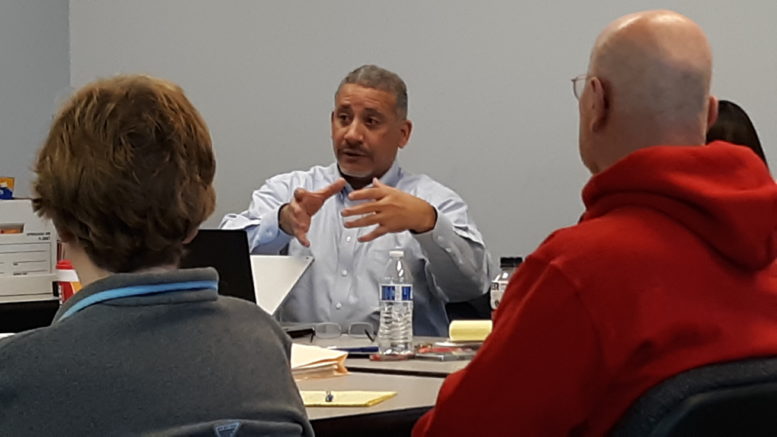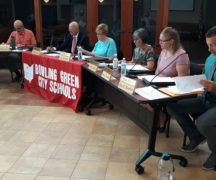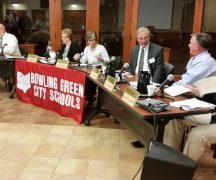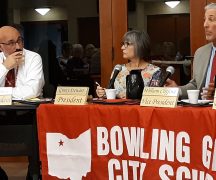By JAN LARSON McLAUGHLIN
BG Independent News
It was deja vu for the Bowling Green Board of Education members as they sat around tables Saturday debating how to finance a new school building. But the board hopes for a different result this time, since the priority is now a new high school – rather than a consolidated elementary.
The board gathered for a 3½-hour workshop to explore how to best finance a new high school, with the goal of placing an issue on the November ballot.
Board members are united in the position that Bowling Green City Schools needs new buildings. But several questions linger.
How much are voters willing to pay for a new high school?
What is the winning combination of property and income taxes to garner voter support?
And how long can the district wait before taking the next step for elementary buildings?
The board is apprehensive about putting a tax issue on the ballot since the last three efforts to fund a new elementary school failed – the last one by just 32 votes.
But there is some confidence that a less controversial goal of a new high school rather than a new consolidated elementary, could get voter support.
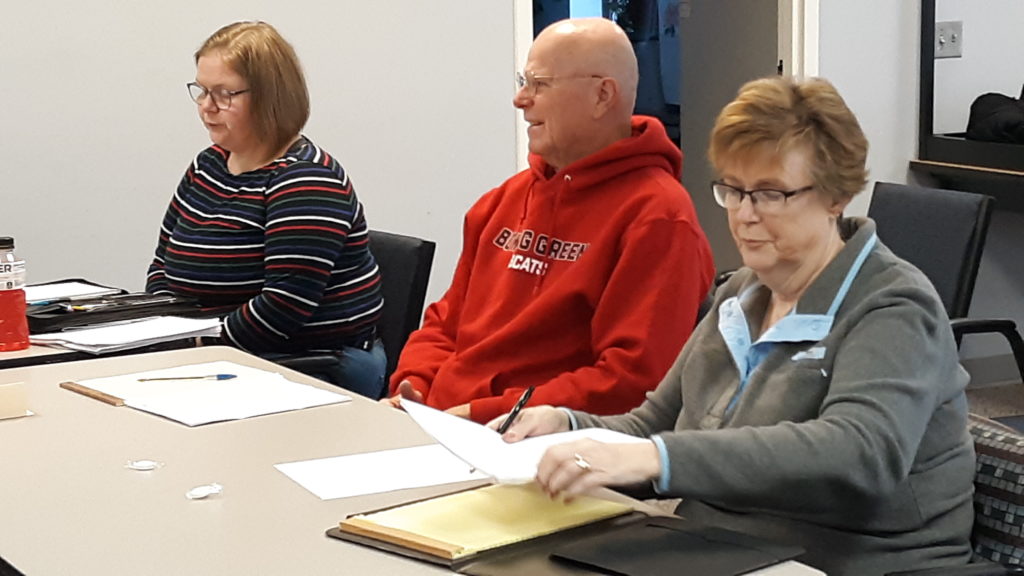
A school facilities committee, made up of a cross section of the district residents, has come to the conclusion that the district’s priority should be a new high school. The committee was split 50/50 on whether the aging elementaries should be replaced with one or two new buildings.
The committee is expected to make a formal recommendation to the school board next month. The board has until Aug. 10 to file a property tax issue with the Wood County Board of Elections for the November ballot. The filing deadline for an income tax is July 26.
The architects working with the school facilities committee, from Fanning Howey, have estimated the cost for a new high school to be between $48 million and $58 million. The range takes into account the costs of building a school based on the 2015 enrollment projections or the current enrollment, which is 300 students lower than in 2015.
Board members expressed concerns that the district will continue to lose students if it doesn’t replace its schools that were constructed in the 1950s and 1960s. Every other district in Wood County has newer buildings.
But the board is gun shy.
“We just can’t handle another loss. That’s what I’m concerned about,” board member Tracy Hovest said. “Why do we have to defend so hard to do the right thing for kids. This is what’s good for kids. This is what’s good for the community.”
David Conley, the school district’s financial consultant, walked the board through some funding options for a new high school.
With property taxes, the addition of new residents and new businesses in the district help bring down the amount collected from the original property owners, Conley explained. The district’s tax base is about 30% businesses.
Property taxes can be raised in any millage, but income taxes for schools can only be increased by 0.25% increments, Conley said.
With income taxes, if the community grows, the revenue will grow. Only residents of the district pay income taxes – not businesses. Income taxes place more burden on the poor in the community, Conley said.
However, the district is sensitive to agricultural property owners, who have said they will support an increase in income taxes but not property taxes.
Conley said he recently met with farmers in another district that he is working with on a ballot issue. The farmers urged that due to rising inflation, now is not the time for new school buildings.
But Conley said waiting only makes the price tag higher.
“The reality is we’re all suffering through a tough time,” he said, not just farmers.
The last school building issue Bowling Green schools put before voters offered a 50/50 split between property and income taxes.
“I feel like that closed the gap,” Hovest said, noting the issue lost by 32 votes.

To give the board a sample of funding options, Conley plugged numbers into a formula that would raise $58 million for a new high school. The numbers were based on the district’s median house value of $161,300 and median family income of $66,215.
Some of those options were:
- Straight property tax of 3.45 mills, which would be $16.50 a month for the owner of a house of median value.
- 50/50 split of property and income tax, requiring 1.72 mills in property tax and 0.25% income tax increase. The result would be $21.87 a month for the median family.
- 70/30 split of property tax and income tax, requiring 2.4 mills in property tax and 0.25% income tax increase – costing the median family $25.10 a month.
The excess money not spent on construction is permitted to be used for maintenance of any school buildings or can be saved for the next construction project, Conley said.
Conley cautioned that bids for buildings are coming in much higher than projected. He is currently working with the Xenia school district on a building that was expected to cost $36 million. The bids came in $13 million higher, he said.
So Conley also plugged in numbers for a ballot issue that would give the district a cushion, raising $65 million. Those options included:
- 70/30 split in property and income taxes, requiring 2.69 mills in property taxes and 0.25% income tax increase. The cost would be $26.47 a month for the median home and family income.
- 75/25 split in property and income taxes, requiring 3.3 mills in property taxes and 0.25% income tax increase. The cost would be $29.31 a month for the median home and family income.
- Straight property tax, costing $19.98 a month for the owner of a $161,300 home.
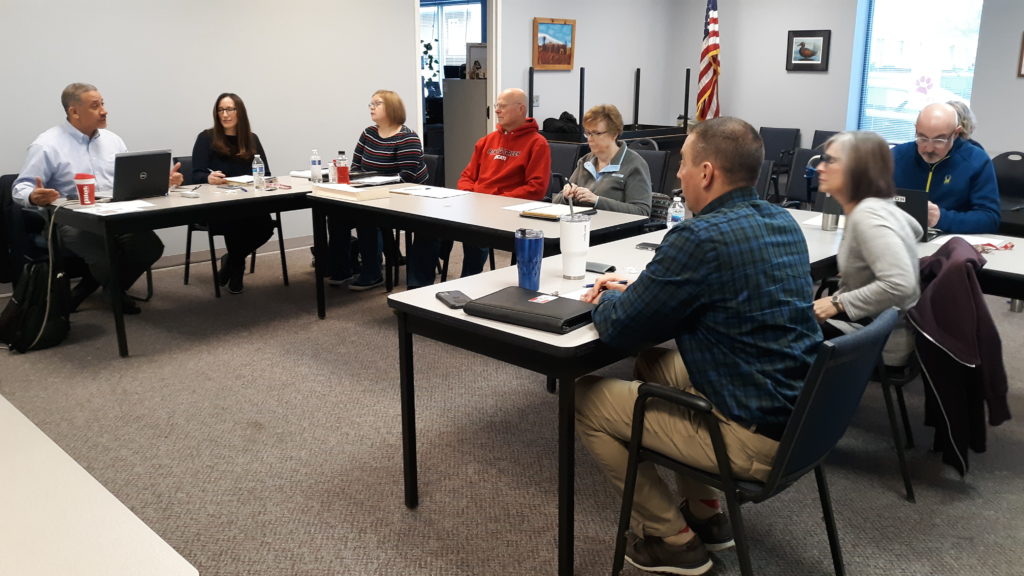
The board was also torn over the desire to build new elementary schools, and the realization that voters are not likely to pass funding for $100 million or more.
Board member Ginny Stewart talked about the economic benefit of passing funding now for all the district’s building needs.
“It’s just going to get more and more and more expensive,” she said. “I just want to look at all the options.”
Stewart also expressed concerns about putting the elementary needs on hold.
“There are people thrilled about the high school, and there are people so disappointed” that new elementary construction will be delayed, Stewart said.
The school facilities committee concluded that building a new high school first would be best since the issue of building one or two new elementaries is still so divisive.
Stewart said the voters have rejected the consolidated elementary three times.
“To me that speaks volumes,” she said, voicing her support of two new elementaries.
Board members were in agreement that the building of new elementaries should not be pushed out too many years.
“We’ve got to start capturing these younger families,” Stewart said.
Superintendent Francis Scruci talked about the ill effects of delaying new elementary buildings.
“How much are we willing to kick the can down the road? If we’re doing the best for our kids,” the district would tackle all the building needs now, he said.
But board member Norm Geer said that would very likely result in failure.
“I’m really focused on getting a building built and following the recommendations of the committee,” he said.
But Geer added that the elementary building efforts should start soon, not wait for the completion of the high school.
Board member Ryan Myers also expressed concerns about trying for a larger ballot issue to pay for multiple new buildings.
“We’re between a rock and a hard place,” Myers said. “Hopefully, the high school will be a catalyst” that will inspire voters to support a future ballot issue for the elementaries.

